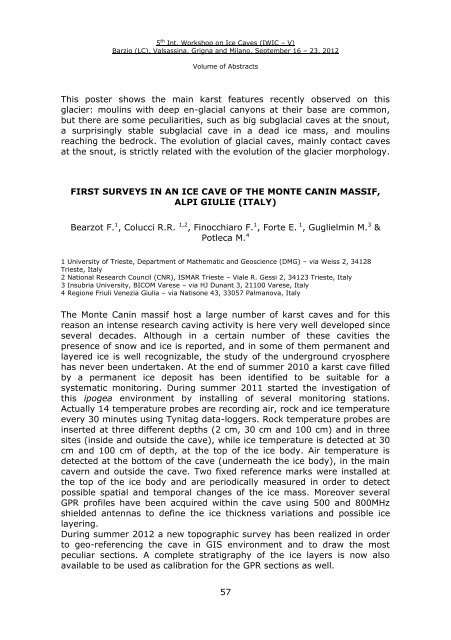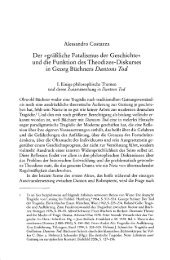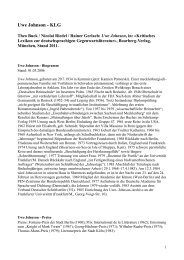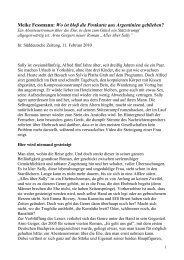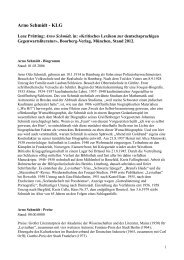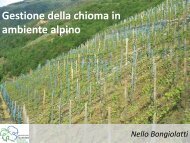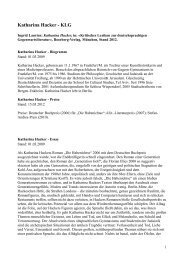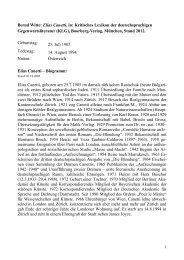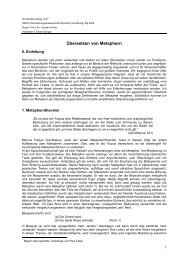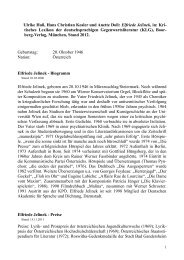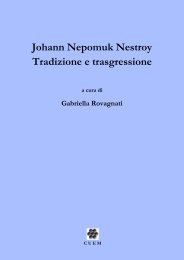Volume of Abstracts - Università degli Studi di Milano
Volume of Abstracts - Università degli Studi di Milano
Volume of Abstracts - Università degli Studi di Milano
You also want an ePaper? Increase the reach of your titles
YUMPU automatically turns print PDFs into web optimized ePapers that Google loves.
5 th Int. Workshop on Ice Caves (IWIC – V)<br />
Barzio (LC), Valsassina, Grigna and <strong>Milano</strong>, September 16 – 23, 2012<br />
<strong>Volume</strong> <strong>of</strong> <strong>Abstracts</strong><br />
This poster shows the main karst features recently observed on this<br />
glacier: moulins with deep en-glacial canyons at their base are common,<br />
but there are some peculiarities, such as big subglacial caves at the snout,<br />
a surprisingly stable subglacial cave in a dead ice mass, and moulins<br />
reaching the bedrock. The evolution <strong>of</strong> glacial caves, mainly contact caves<br />
at the snout, is strictly related with the evolution <strong>of</strong> the glacier morphology.<br />
FIRST SURVEYS IN AN ICE CAVE OF THE MONTE CANIN MASSIF,<br />
ALPI GIULIE (ITALY)<br />
Bearzot F. 1 , Colucci R.R. 1,2 , Finocchiaro F. 1 , Forte E. 1 , Guglielmin M. 3 &<br />
Potleca M. 4<br />
1 University <strong>of</strong> Trieste, Department <strong>of</strong> Mathematic and Geoscience (DMG) – via Weiss 2, 34128<br />
Trieste, Italy<br />
2 National Research Council (CNR), ISMAR Trieste – Viale R. Gessi 2, 34123 Trieste, Italy<br />
3 Insubria University, BICOM Varese – via HJ Dunant 3, 21100 Varese, Italy<br />
4 Regione Friuli Venezia Giulia – via Natisone 43, 33057 Palmanova, Italy<br />
The Monte Canin massif host a large number <strong>of</strong> karst caves and for this<br />
reason an intense research caving activity is here very well developed since<br />
several decades. Although in a certain number <strong>of</strong> these cavities the<br />
presence <strong>of</strong> snow and ice is reported, and in some <strong>of</strong> them permanent and<br />
layered ice is well recognizable, the study <strong>of</strong> the underground cryosphere<br />
has never been undertaken. At the end <strong>of</strong> summer 2010 a karst cave filled<br />
by a permanent ice deposit has been identified to be suitable for a<br />
systematic monitoring. During summer 2011 started the investigation <strong>of</strong><br />
this ipogea environment by installing <strong>of</strong> several monitoring stations.<br />
Actually 14 temperature probes are recor<strong>di</strong>ng air, rock and ice temperature<br />
every 30 minutes using Tynitag data-loggers. Rock temperature probes are<br />
inserted at three <strong>di</strong>fferent depths (2 cm, 30 cm and 100 cm) and in three<br />
sites (inside and outside the cave), while ice temperature is detected at 30<br />
cm and 100 cm <strong>of</strong> depth, at the top <strong>of</strong> the ice body. Air temperature is<br />
detected at the bottom <strong>of</strong> the cave (underneath the ice body), in the main<br />
cavern and outside the cave. Two fixed reference marks were installed at<br />
the top <strong>of</strong> the ice body and are perio<strong>di</strong>cally measured in order to detect<br />
possible spatial and temporal changes <strong>of</strong> the ice mass. Moreover several<br />
GPR pr<strong>of</strong>iles have been acquired within the cave using 500 and 800MHz<br />
shielded antennas to define the ice thickness variations and possible ice<br />
layering.<br />
During summer 2012 a new topographic survey has been realized in order<br />
to geo-referencing the cave in GIS environment and to draw the most<br />
peculiar sections. A complete stratigraphy <strong>of</strong> the ice layers is now also<br />
available to be used as calibration for the GPR sections as well.<br />
57


